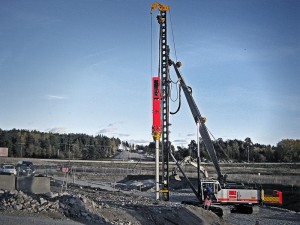Ramtech’s upcoming commercial modular office building project for Cameron LNG, a liquefied natural gas processing facility located in the delta of southern Louisiana, will present some unique structural design challenges. These include resisting wind speeds of 150 mph, the potential of blast forces created by an accidental explosion, and the structurally weak soils that exist at the building location.
The Louisiana delta was formed from sediment picked up by the flowing water along the Mississippi River’s path which is then deposited at the river’s end. These soils are loose silts which provide almost no structural strength, certainly not enough to support a modular building let alone the other heavy processing equipment that will exist at the site. This type of environment calls for foundations that are typically supported by piles that are drilled or driven into the ground instead of using spread footings which we use in most of the areas in which we do work.
 A wood pile made from pine or spruce trees is the oldest and most common type of piling. They are normally driven into the ground using a hydraulic press or hammer until it meets the resistance required to provide the needed support. While our typical foundations are concerned with the surface bearing capacity of the soil to support a spread type foundation footing, a pile foundation uses skin friction between the surface of the pile and the soil to create the resistance which provides the support. The building for Cameron LNG will require a concrete slab floor so we plan to use our Accelerated Building System (ABS) permanent modular construction process. The ABS method will allow us to pour a slab which will be structurally supported by piles driven deep into the ground. The piles will have a concrete cap used to support the slab along with integral concrete beams to collect and transfer the loads to the piles. Ramtech has previously used piles on two projects that were located in the same general area and had conditions similar to this job, but this will be the first building to incorporate a concrete slab with this foundation system, another solid achievement using the ABS process.
A wood pile made from pine or spruce trees is the oldest and most common type of piling. They are normally driven into the ground using a hydraulic press or hammer until it meets the resistance required to provide the needed support. While our typical foundations are concerned with the surface bearing capacity of the soil to support a spread type foundation footing, a pile foundation uses skin friction between the surface of the pile and the soil to create the resistance which provides the support. The building for Cameron LNG will require a concrete slab floor so we plan to use our Accelerated Building System (ABS) permanent modular construction process. The ABS method will allow us to pour a slab which will be structurally supported by piles driven deep into the ground. The piles will have a concrete cap used to support the slab along with integral concrete beams to collect and transfer the loads to the piles. Ramtech has previously used piles on two projects that were located in the same general area and had conditions similar to this job, but this will be the first building to incorporate a concrete slab with this foundation system, another solid achievement using the ABS process.
